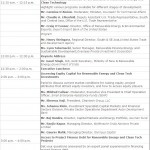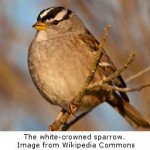After studying the Life’s Principles chart, one truth became apparent: Nature has strict boundaries when it came to resources. Cities don’t. Especially when it came to water, organisms had very specific ways for dealing with conservation during times of scarcity. Grass will go dormant during droughts. Birds will conserve food for the good of the group. Animals and plants have a very intrinsic ability to monitor and self-regulate, whereas humans are so far removed from this cycle that they only pay attention when they experience what the designers named a “heart attack moment” where resources have been depleted and it’s too late. “Animals regulate based on ambient conditions – they do for themselves but also for the good of the species,” says Booth. “So how do you make those signals apparent? How can we bring out those concepts so we’re looking at those boundaries and limits?”

Click the image to view Smart Design’s interpretation of the Life’s Principles for urban ecosystems at a larger size.
Using the chart as their guide, the designers began framing a three-level approach to that would provide tangible and relevant feedback loops in different layers: individual (organism), communal (species), and societal (species to species).
For the individual layer, Smart Design wanted a non-intrusive, yet tangible way to show residents how much water they were using. They created the Heartbeat Faucet, which provides feedback by pulsing after dispensing every 12-oz. cup of water – approximately 20-30 times a minute for the typical faucet. This metered pulse would allow users to see and feel how much water they are using each time they turn on the faucet, informing everyone in the household about their behavior. The faucet would also give IBM point-of-use metering for real time analytics.
For the communal layer, Smart Design focused on the concept of “leveraging interdependence”, or creating cooperative behavior. For this solution they looked at the idea of a Communal Reservoir, which would encourage groups to work together. In an urban environment, Smart Design decided, a reservoir would translate to the water used by an entire apartment building: Water usage is typically metered for a whole building but each resident often has no idea how much or little they’re contributing to the bill. This program would track your building’s water usage during a fixed time period and give a community reward – from municipal tax credits to flowers for the lobby – if you come in below your target. The elevator could then serve as the “town square”, with displays that show the building’s reservoir level and allow the community to modify behavior on daily basis.
Finally, for the societal layer, Smart Design needed a way to quickly convey the city’s water health to its residents and reconnect cities to the natural resources their inhabitants depend on for survival. “When people used to have to pick up their water, they could see the stream or the well, and know to conserve,” says Booth. “We have no real connection to that.” They created the concept of MicroParks, tiny green spaces throughout the city located next to fire hydrants retrofitted with solar powered wireless water metering systems. The MicroParks’ water feed could be manipulated to reflect the cities future water supply – a lush MicroPark would communicate a healthy water supply and a withering MicroPark would let residents know that conservation is critical. These miniature green spaces can forecast city water supply health and make behavior-changing daily connections with people in a positive way.
Smart Design was able to use the concepts of an entire ecosystem as a metaphor for a city environment, moving from very micro examples from nature into an application like the Life’s Principles that applied nature in a very macro, big-picture way. This resulted in a solution that they felt was more appropriate than the traditional biomimicry approach of inscribing specific organisms’ traits upon urban infrastructure and human behaviors. “We felt we lacked the credibility to say we can take the corky tuber and turn it into a reservoir,” says Fort of the limited time and experience in biomimicry. “But it was valuable to think about things from a different perspective.”
Although Dorfman didn’t expect the team to make the Life’s Principles the centerpiece of their solution, he thought it made an excellent bridge for designers to work between life’s technologies and human behavior. “Most often, I’ve used Life’s Principles to evaluate a potential solution that we’ve proposed to a client, so it was quite interesting to see the team use Life’s Principles as both the inspiration for ideas as well as a tool to evaluate its sustainability,” he says. “It was actually quite exciting to see the design team run with it.”
The designers will now use the Life’s Principles as another tool in their tool-kit, much like the way Smart Design already uses the principles of Universal Design, a process of designing products and environments that are usable by people with a wide range of abilities. It will remind them that nature is often the best role model for elegant solutions. And for this solution, it also helped them to realize a simple truth: That some of the world’s largest challenges will be overcome by changing the behavior of each individual within a larger system. “The modern city is just like an ecosystem,” says Fort. “It seems so obvious, but if you just go right below the surface, there are all these inspirations and connections that are so meaningful.”
About The Designers Accord
The Designers Accord is a global coalition of designers, educators, and business leaders, working together to create positive environmental and social impact. The firm was founded in June 2007 with the goal of changing the way the creative community does business. The underlying philosophy was that by collectively building our intelligence around issues of climate change and humanitarian issues – and tackling those challenges with optimism and creativity – we would catalyze innovative and sustainable problem solving throughout the creative community. For more information, please visit http://www.designersaccord.org/
About Fast Company
Fast Company is a magazine and website charting the evolution of business through a unique focus on creative individuals who spark change in the marketplace. This story Biomimicry Challenge: For IBM, Smart Design Draws Water Conservation Inspiration From Ecosystems originally appeared as part of the Designers Accord Case Studies on Fast Company website. For more information, do visit http://www.fastcompany.com/














